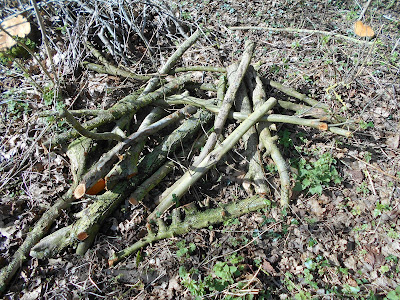For many centuries coppicing was a widespread activity involving the cutting down of a tree near to the base of the trunk with the object of providing a crop of poles for hurdles and so on as re-growth took place from the stool. The practice began to die out, perhaps as labour became scarce in the countryside, but has been revived over recent decades when it became evident that so much of our woodland flora - primroses, bluebells and the like - was beginning to disappear. Coppicing allows sunlight to penetrate to the woodland floor and is regarded generally as good woodland management. It could be argued that in some woodlands it is done to an excess but in Byfield Pocket Park it is certainly needed and I assume some sort of rotational coppicing may be the aim (the cycle was generally a ten- or fifteen-year one, depending on the sort of poles required).
 |
Hazel stool left by coppicing in Byfield Pocket Park.
4 March, 2017
|
One problem with coppicing is that the tender young growth so produced may be browsed, and sometimes rendered useless, by deer. The answer was pollarding, where the trunk was cut through perhaps eight or ten feet above the ground, producing young growth beyond the reach of deer. (I should hasten to add that hazel is not pollarded.) In theory most broad-leaved trees can be coppiced but pines and many other conifers do not respond and simply die. The usual target-species for this treatment is hazel but in Byfield's pocket park stand a few Spindle Trees, Euonymus europaeus, and I was concerned that these may have been coppiced. I need not have worried; they had been spared and were putting on plenty of spring growth.
 |
A sweeping branch of Spindle shows off its new growth. Byfield
Pocket Park, 4 March, 2017
|
Not that it would have mattered in the long term; we would simply have been deprived of its flowers and fruits for a year.
 |
A vitally important habitat. Dead wood beneath the trees in
Byfield Pocket Park. 4 March, 2017
|
I was delighted to see that the pruned growth had been gather up into a few suitable spots and left to decay. This will probably lead to a complaint or two but this decomposition process is of long-term benefit.
For many mini-beasts, especially woodlice and beetles, decaying timber is an important, even essential, habitat and I anticipate that these little piles of wood will soon be colonised. Logs are best for the encouragement of wildlife and in his excellent book, No Nettles Required (Eden Project Books, 2006) Ken Thompson tells of an experiment in which birch logs were stacked in twenty gardens. Two years later the stacks were examined and 'frogs, mites, harvestmen, spiders, centipedes, millipedes, woodlice, earthworms, flatworms, snails, slugs, springtails, ground beetles, rove beetles, bugs and flies' were revealed.
The pocket park contains a number of young Ash trees, Fraxinus excelsior, and I see that Pom and her co-workers have removed a number of these. Ash is such a common species hereabouts that their loss is of no importance and again their loss may be of long-term benefit. In effect these trees have been coppiced and there may be some growth from the stools; time will tell.
The pocket park contains a number of young Ash trees, Fraxinus excelsior, and I see that Pom and her co-workers have removed a number of these. Ash is such a common species hereabouts that their loss is of no importance and again their loss may be of long-term benefit. In effect these trees have been coppiced and there may be some growth from the stools; time will tell.
 |
| Stools of young ash trees. Byfield Pocket Park, 4 March, 2017 |
Anyway, the overall benefit of this management has been the opening-up of areas and perhaps, with a little human help, the establishment of Wood Anemones and Primroses - hopefully using seeds or plants from an unimpeachable British source. (Whoops! How racist does that sound!)
At the time of the pocket park's creation a number of 'Field Maples' were planted. The Field Maple, Acer campestre, is an important species (with impeccable British credentials!) but I have long held suspicions about the true taxon involved in this planting. There is something not quite right about them and I really ought to give them a closer examination. To be fair however, they do sustain a number of other species, especially galls, so perhaps their removal could not be justified. A splendid start has been made to the recovery/restoration of the area and I hope the work is appreciated.
No comments:
Post a Comment